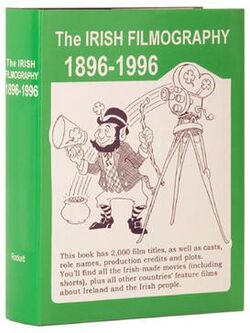The Irish Filmography
 | |
| Author | Kevin Rockett |
|---|---|
| Cover artist | Mark Kausler |
| Country | Ireland |
| Language | English |
| Subject | Cinema |
| Publisher | Red Mountain Media |
Publication date | 1996 |
| Pages | 757 |
| ISBN | ISBN:0-913616-35-4 |
The Irish Filmography: Fiction Films 1896-1996 is a 757-page reference catalog of movies and short films produced from 1896 to 1996 in Ireland, or about Ireland and the Irish.[1] It was published in 1996 by Red Mountain Press, a company in Dublin, Ireland. The chief editor was Kevin Rockett.[2][3]
The catalog has a title index of approximately 2,000 films. Approximately one-tenth of those are Irish productions. The remainder, produced outside Ireland, are films about Ireland and the Irish diaspora. About one-half of the titles are United States films; another quarter are Australia n and United Kingdom films. There are also films from Belgium, Canada , France , Germany , the Netherlands, Israel, Italy, Russia , and Spain .[2][4][5][6]
Arrangement of information
Films are grouped by country of origin, then by chronology within each nationality. Many entries have extensive detail including production credits, actors with role names, narrative synopsis, production and distribution companies, running time, color process, sound system, literary source and review citations.[4]
Inclusion criteria
For non-Irish productions, the reason for inclusion usually is obvious, such as a setting in Ireland or a story about people of Irish heritage. Films set in other countries also qualify if shot in Ireland. Even one Irish character in a film’s story qualifies that film for inclusion, such as Brigid O’Shaughnessy (played by Mary Astor) in The Maltese Falcon (1941).
All films about John F. Kennedy are included, even those in which that historical character doesn’t appear; for example, the book has a detailed entry for Executive Action, a fictional story about a conspiracy to assassinate Kennedy.
Back to the Future (1985) has a detailed entry, owing to a scene in the Diner at the beginning when local bully Biff Tannan refers to Marty's father as 'Irish' in a derogatory fashion. Popeye Doyle (played by Gene Hackman) in The French Connection likewise qualifies as an Irish character; in the movie Doyle remarks 'kiss my Irish ass!' after he has got drunk on whiskey with a friendly French waiter.
Additional indexes
In addition to the index of film titles, the book also has the following indexes:
- Personal Names
- Corporate Names
- Composers and Songwriters
- Literary and Dramatic Sources
Reception
Filmmaker Bob Quinn stated the book is "an extraordinary opus ... Rockett is an excellent and painstaking scholar. Never before has anybody attempted to document in one volume every film ever made in or about Ireland. ... The amount of detail he has unearthed is no less than stupendous. ... The nearest literary analogy I can think of is Dineen's Irish Dictionary",[7] Jeff Brownrigg of Australia 's National Film and Sound Archive writes that the book is "an indispensable tool for the researcher." and that it "provides a valuable source of information about a large group of international narrative feature films gathered together under the head of their general association with Ireland." He writes of the book's nearly two thousand entries and makes note of its comprehensive nature, concluding that it "is clearly an essential reference for libraries and will be sought by film buffs."[2] Trinity College Dublin notes that the impetus for the creation of 'Irish Film & TV Research Online Film & Television Index' was Kevin Rockett's The Irish Filmography: Fiction Films 1896 - 1996, due to its documenting "all fiction films made in Ireland and about Ireland and the Irish produced worldwide since the beginnings of cinema".[8] In Postcolonial and Gender Perspectives in Irish Studies, author Marisol Morales Ladrón wites that The Irish Filmography is a "wide-ranging directory", and notes that it contains information even on titles which have been lost.[9] In Projecting ethnicity and race: an annotated bibliography of studies on imagery in American film, it is offered that "The sheer bulk of the 757 page, telephone book-sized work suggests the comprehensive breadth and detail offered..."[4]
Further reading
- 1987, Cinema and Ireland By Kevin Rockett, Luke Gibbons, John Hill ISBN:0-7099-4216-8
- 1996, The companion to British and Irish cinema By John Caughie, Kevin Rockett ISBN:0-304-34158-4
- 2004, Irish film censorship: a cultural journey from silent cinema to internet By Kevin Rockett, Emer Rockett ISBN:1-85182-844-3
References
- ↑ Gillespie, Michael Patrick (2008). The myth of an Irish cinema: approaching Irish-themed films (illustrated ed.). Syracuse University Press. pp. 29. ISBN 9780815631682. https://books.google.com/books?id=qeiVbuwTr0wC&pg=PA29&dq=%22The+Irish+Filmography%22&cd=4#v=onepage&q=%22The%20Irish%20Filmography%22&f=false. Retrieved 21 December 2009.
- ↑ 2.0 2.1 2.2 Brownrigg, Jeff. "review: The Irish filmography: fiction films 1896 - 1996". National Film and Sound Archive. La Trobe University. Archived from the original on 13 October 2008. https://web.archive.org/web/20081013051726/http://www.latrobe.edu.au/screeningthepast/shorts/reviews/rocket.html. Retrieved 22 December 2009.
- ↑ Review Film Ireland magazine; #53 June–July 1996
- ↑ 4.0 4.1 4.2 Marsha J. Hamilton, Eleanor S. Block (2003). Projecting ethnicity and race: an annotated bibliography of studies on imagery in American film (annotated ed.). Greenwood Publishing Group. pp. 140. ISBN 9780313317415. https://books.google.com/books?id=lW_cbSemd3sC&pg=PA140&lpg=PA140&dq=%22The+Irish+Filmography%22&source=bl&ots=pRXlICmbul&sig=X9O0sxCUdQHlJMr1_VTjZ5nRnx4&hl=en&ei=VXQwS7jlOo7IsAPyhJy_BA&sa=X&oi=book_result&ct=result&resnum=3&ved=0CA8Q6AEwAjgU#v=onepage&q=%22The%20Irish%20Filmography%22&f=false. Retrieved 21 December 2009.
- ↑ Crosson, Sean. "Vanishing Point: An examination of some consequences of globalization for contemporary Irish film". Journal of Interdisciplinary Celtic Studies. University of Wisconsin. pp. Volume 2, Cultural Survival. http://www4.uwm.edu/celtic/ekeltoi/volumes/vol2/2_1/crosson_2_1.html. Retrieved 22 December 2009.
- ↑ Casademont, Rosa Gonzalez (2002). "Ireland on Screen. A view from Spain". International Journal of English Studies (University of Murcia) 2 (2). http://dialnet.unirioja.es/servlet/fichero_articulo?codigo=299067&orden=0. Retrieved 21 December 2009.
- ↑ staff. "School of Drama, Film and Music, Staff bio". Trinity College, Dublin. http://tcdlocalportal.tcd.ie/pls/public/staff.detail?p_unit=drama&p_name=krockett. Retrieved 23 December 2009.
- ↑ "Irish Film & TV Research Online". Trinity College Dublin. http://www.tcd.ie/irishfilm/. Retrieved 22 December 2009.
- ↑ Ladrón, Marisol Morales (2007). Postcolonial and Gender Perspectives in Irish Studies. Netbiblo. pp. 205. ISBN 9780972989268. https://books.google.com/books?id=zTWo_mySN1UC&pg=PA205&lpg=PA205&dq=%22The+Irish+Filmography%22&source=bl&ots=cTWZDokzu2&sig=o4t7dN5rVYMlu4qxLDPGeGTnonc&hl=en&ei=KnIwS7uzLIbetgPMsN2sBQ&sa=X&oi=book_result&ct=result&resnum=5&ved=0CBQQ6AEwBDgK#v=onepage&q=%22The%20Irish%20Filmography%22&f=false. Retrieved 21 December 2009.
External links
- 1997, The Irish Filmography: Fiction Films 1896-1996 By Kevin Rockett ISBN:0-913616-35-4

